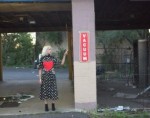
Grappling With Whiteness in a Field of Poppies
by Nicole Bindler
In the opening moments of her piece, “Hello! Sadness!,” Mary Tuomanen leans her lithe torso backward and her arms forward in an ecstatic embrace of nothing. She says she is in a place where she is “totally safe,” where “the idea of helping other people is gone … no systemic oppression, no experts, no history.” She sways euphorically in front of a field of poppies projected onto the back scrim at FringeArts. Adriano Shaplin’s sound score drones ominously, peppered with sounds of birds chirping.
Poppies remain dormant for years before bursting into red glory, as do revolutions. Poppies are also the source of opiates like the ones that killed Jean Seberg, the actress who played Joan of Arc in the 1957 film, Saint Joan. We also learn from Tuomanen that Seberg supported the Black Panther Party and, as a result, was tormented by FBI agents through COINTELPRO.
Tuomanen looks like Seberg, demonstrates her glee at the resemblance by framing her face with her hands at right angles and glancing back at an image of Seberg with a grin. She replicates Seberg’s movements in projected footage. They strut, laugh, and flirt in precise unison. She embodies both herself and an imagined Seberg as they walk through the field of poppies, chatting in bad French, holding hands like best friends.
Our protagonist is beyond the age when Joan of Arc, Jean Seberg, and Fred Hampton of the Black Panther party made history and were martyred. She seems preoccupied with not having made her mark as a revolutionary, nor even a scratch: “I never threw a garbage can through a Starbucks window.” Tuomanen describes herself as “small and dismissible.” She stands impotently, with a collapsed spine as she describes her scrappy cardboard signs at protests and her role as the trash collector at Occupy.
In a non sequitur, Joan of Arc’s wax head in a museum is stolen by a nameless thief (also played by Tuomanen, as are all the characters), who then transforms into the comedian, Daniel Tosh. Tuomanen as Tosh tells dead baby and pedophile jokes while holding the imaginary wax head. In an extremely dark turn, the Tosh character mimes raping the head through forced fellatio. “Oh come on,” the comedian says in textbook toxic masculine form: “There’s no blood, like it never even happened.... You’re not going to be a bitch about it?”
Tuomanen cries: “I’m sorry I couldn’t stop it. I’m too small.” She writhes and thrashes on the floor. Her limbs torque as if bound by an attacker. Her skillful physicalization of assault, repeated with exactitude twice, no doubt was strengthened by the direction of choreographer Annie Wilson, who has a track record of embodying challenging topics in her dances.
The brave soloist then takes on Françoise Sagan, author of the book Bonjour Tristesse (Seberg acted in the film adaptation). Sagan drives her luxury car at 160 KPH while intoxicated and allows Seberg to slowly die in the back of her car from an overdose. The timely and poignant metaphor of the narcissist callously allowing the idealist to perish on their watch is not lost on this writer.
Tuomanen alternately plays the roles of herself, Jean Seberg, Joan of Arc, Françoise Sagan, and Daniel Tosh, but conscientiously does not take on the voice of Fred Hampton. Instead she plays a video of a trial in which he defended himself: “We don’t think you fight fire with fire best; we think you fight fire with water best. We’re going to fight racism not with racism, but we’re going to fight with solidarity. We say we’re not going to fight capitalism with black capitalism, but we’re going to fight it with socialism.”
Throughout the piece Tuomanen uses repetition of various elements as a device to layer meaning: projections of COINTELPRO-like documents detailing attacks on the various heroes; French New Wave music and dancing; fields of poppies; rants about the futility of her activism.
Tuomanen interrogates her role as a white artist/activist in this particularly troubling time with a tinge of shame and a preoccupation with individual heroism. This stance risks perpetuating the capitalist idea of personal success outshining collaboration within a broader movement. But at the end, she squats in a warrior stance, shouts with rage and sarcasm: “... we struggled into failure and did ridiculous, unjustifiable things, cross-dressing and feeding children and demanding respect for each other’s personhood demanding respect for our own personhood....” In these final moments her self-consciousness falls away and is replaced by impassioned clarity.
Hello! Sadness! Mary Tuomanen, FringeArts, January 26th, 27th & 28th.
By Nicole Bindler
February 3, 2017






.png)


